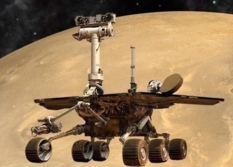A.J.S. Rayl • Jul 02, 2015
Mars Exploration Rovers Update: Opportunity Phones Home after Conjunction Healthy, Ready to Rove
Sols 4036 - 4064
After three weeks of being in a communications blackout on the other side of the Sun during the Earth-Mars solar conjunction, Opportunity phoned home from the rim of Spirit of St. Louis Crater on June 24th reporting that she is healthy and ready to continue the Mars Exploration Rover (MER) mission.
The MER ops team immediately resumed normal tactical planning, preparing its first post conjunction commands for the rover. The following day, Opportunity was back to taking images and working at the northern rim of Spirit of St. Louis Crater, the small, oblong crater that lies near the entrance of Marathon Valley, along the western rim of the much larger, 22-kilometer (13.7 mile) diameter Endeavour Crater.
“Opportunity came through solar conjunction with flying colors and is now dutifully carrying out her science assignments,” said Bill Nelson, chief of MER engineering at the Jet Propulsion Laboratory (JPL), home to all NASA’s Mars rovers.
Many of the MER team members took a much-needed break during the Earth-Mars Solar Conjunction command moratorium and communication blackout, said John Callas, MER project manager, at JPL. "We took advantage of the solar conjunction quiet period to take some time off and now we're back and rolling," he said.
Solar conjunction is a celestial event that occurs once every 26 months or so when Mars orbits behind the Sun from our perspective on Earth. This geometry disrupts radio communications between the planets, so to prevent Opportunity from receiving garbled commands that could be misinterpreted or even harmful, a temporary moratorium on sending commands and a communication blackout is routinely instituted during this period.
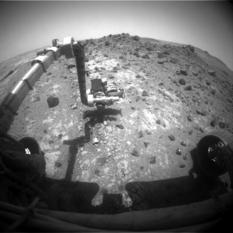
Examining Priv. William Bratton
Opportunity hunkered down for the Earth-Mars Solar conjunction command moratorium and communication blackout in a red alteration zone that can be seen in different parts of the rim of Spirit of St. Louis Crater. The team named the area over which she perched after Private William Bratton, after a member of the Corps of Discovery Expedition. During solar conjunction, the rover spent most of June using her Alpha Particle X-ray Spectrometer (APXS) gleaning the chemical composition of two targets in the red zone area that features a scattering of small, broken-up small rocks.NASA / JPL-Caltech
With 42.37 kilometers (26.33 miles) on her odometer and producing just under 500 watt-hours of power, about half of her full power capability, the veteran robot field geologist hunkered down on June 3rd under hazy skies to wait out conjunction. The rover parked on the northern rim of Spirit of St. Louis Crater in a “red alteration zone,” as Matt Golombek, MER project scientist of JPL, described it. The red zone, which features a scattering small, broken up rocks, can be seen along different sections of the small crater's rim.
Opportunity spent the three weeks of the solar conjunction blackout there using her Alpha Particle X-ray Spectrometer (APXS) to analyze the chemical make-up on two selected surface targets in a section of this rocky red zone named after Private William Bratton, a member of the Corps of Discovery, better known as the Lewis and Clark expedition.
The MER scientists will be using the science data Opportunity collected at Private William Bratton to compare the red alteration zone findings with the rocks and soil materials that the rover checked out inside and around Spirit of St. Louis Crater.
Since the rover's troublesome non-volatile flash memory – basically her long-term memory that saves data after she powers down overnight – was taken "offline" prior to solar conjunction, Opportunity operated in persistent RAM mode throughout the blackout and all of her conjunction-period data was uplinked to one of NASA's Mars orbiters before she went to sleep each night. As reported in these pages many times, RAM is the rover's volatile memory and so each sol’s data must be uplinked to an orbiter before the rover shuts down for the night or it will be lost.
Opportunity sent most of her data from her solar conjunction science campaign at Private William Bratton to the Mars Odyssey orbiter during the blackout, though on two passes she uplinked her research to the Mars Reconnaissance Orbiter (MRO).
The MER mission has relied primarily on Odyssey during the last 11 and a half years, a largely unsung hero at Mars. Named after Sir Arthur C. Clarke's 2001: A Space Odyssey, the workhorse orbiter arrived at Mars in October 2001 and holds the record as longest-operating spacecraft ever sent to Mars. MRO dropped into orbit at the Red Planet in March 2006 about two years after Spirit and Opportunity bounced down on Mars.
While the orbiters were able to relay some of Opportunity's data to Earth during solar conjunction, all of the rover's science research and engineering information was also stored in buffers on those orbiting spacecraft for downlinking in what the engineers call a "full buffer dump" following the biannual celestial event.
On June 23rd, just before Opportunity phoned home, Odyssey achieved another major milestone – completing its 60,000th orbit since arriving at the Red Planet, no pit stops – and then went about the business of downlinking all the rover's data stored in its buffer as the rover got back to work on the surface.
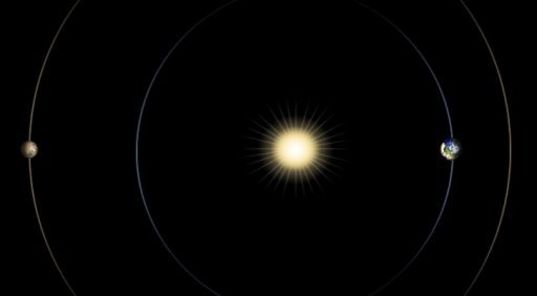
NASA / JPL-Caltech
Earth-Mars solar conjunction
Earth-Mars solar conjunction is a regular celestial event that occurs once every 26 months or so, when the orbits of Earth and Mars align them on opposite sides of the Sun. During this time, the Sun disrupts radio transmissions between the two planets, so the MER team initiated a communications blackout from June 3rd to June 24th this year. Opportunity worked on 'autopilot' at Private William Bratton following commands uploaded before solar conjunction began.Opportunity emerged fresh from her sixth Earth-Mars solar conjunction and began her Sol 4059 (June 25, 2015) taking images of some of her own tracks, her deck, and the area just in front of her position at Private William Bratton. The MER scientists will compare these images with images of the same targets taken before solar conjunction to look for any changes.
The rover also used her panoramic camera (Pancam) to re-shoot some images she had taken before hunkering down for solar conjunction and which had not been received on Earth. “This was basically a recovery plan,” said Ray Arvidson, MER deputy principal investigator of Washington University St. Louis. “We wanted to recover some images that we didn't get down, some Pancam frames that were missing."
The MER scientists are now looking at the data Opportunity sent home from Private William Bratton. At the same time, they are still writing the story of Spirit of St. Louis Crater.
“It's all interesting,” Arvidson said. “The Spirit of St. Louis rocks are different than anything we've seen.”
While all the rocks Opportunity that has examined in and around Spirit of St. Louis Crater are breccias – rocks formed of broken fragments of minerals and/or rock cemented together by a fine-grained matrix during the impact that created Endeavour Crater some 3 to 4 billion years ago – “they are all enriched in silicon and aluminum with a little bit of sulfur, yet are all slightly different,” said Arvidson.
With the exception of the dark rocks on Lindbergh Mound – the strange cairn-like pile of rocks inside the small crater, which for now remains an enigma – the whole Spirit of St. Louis Crater area seems to have been “pretty well altered by fluids,” Arvidson added. “But we're still exploring this area and still trying to work out the story.”
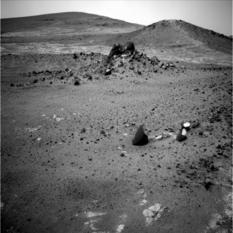
Lindbergh Mound
Opportunity took this image of Lindbergh Mound, a strange stack of rocks just inside the small, shallow, oblong Spirit of St. Louis Crater, with her Navigation Camera. The rover investigated this cairn-like Martian formation in May 2015. It was named in honor of Charles A. Lindbergh, who on May 20-21, 1927, flew from New York over the Atlantic Ocean to Paris in a single engine, high-wing monoplane. It was the first solo, non-stop TransAtlantic flight. "Lucky Lindy," as he came to be known, became the first person in history to be in New York one day and Paris the next.NASA / JPL-Caltech
During the last weekend in June, Opportunity finished up work on Private William Bratton and then drove a short 1.25 meters (4.1 feet) to the southeast to begin a kind of transect, "to take begin taking measurements on either side of the red rocks on the northern rim of Spirit of Saint Louis Crater," said Arvidson.
The robot field geologist, for now, is still relying on her RAM memory to store her data. “We will stay in persistent RAM mode for the foreseeable future while we continue to investigate the sudden reboots or warm resets and amnesia events that have been occurring and which we attribute to Opportunity’s flash or long-term memory,” Nelson said.
The investigation into Opportunity's flash issue is a world-class effort. A group of former MER engineers who worked on the electronics and software programming of Spirit and Opportunity back in the beginning joined forces a couple of months ago with current ops engineers on a flash tiger team led by Bekah Sosland, MER flight director and Tactical Downlink Lead, to dig deeper into the rover's flash memory problems, as reported in the April and May MER Updates.
"We may take 'toe-dips' back into using flash periodically to see what the rover tells us, but for now we're trying to see if we can learn more about what's going on," said Nelson, who is part of the flash investigation team.
"While it is inconvenient not to have flash, its not a big impact on the mission," said Callas. "It kind of like being a grad student who goes to the all-you-can to buffet, loads up, and then brings food back to the refrigerator in dorm room to eat later," he said metaphorically speaking. "For now, we don't have a 'refrigerator,' so we have to eat it or throw it out. However, we have shown that we can operate in persistent RAM mode and still have a very productive science mission."
Once Opportunity finishes imaging and gleaning data from either side of the red rocks on the northern rim of Spirit of Saint Louis Crater, the plan roving forward calls for the robot field geologist to at long last drive to the entrance of Marathon Valley. The valley is where data from the Compact Reconnaissance Imaging Spectrometer for Mars (CRISM) onboard the Mars Reconnaissance Orbiter, a visible-infrared spectrometer onboard MRO which searches for signs of past and present water, first detected a mother lode of various kinds of clay minerals in 2009. [See citation at end of report]
The whole MER team is more than ready to finally get into the valley, but they’re not rushing it. “We will go to the entrance of Marathon Valley, stop, and take some panoramas of the interior to better understand what's there, and figure out what to do,” said Arvidson. At month's end, the plan was to "drive to Marathon Valley next week," he said.
Although planetary scientists have long known that Endeavour Crater formed some 3 to 4 billion years ago, it wasn't until a year after Opportunity arrived at the 22-kilometer diameter hole in the ground that the robot first drove onto Noachian terrain, the first Mars surface mission to rove onto this ancient ground, the first to travel geologically this far back in Martian time.
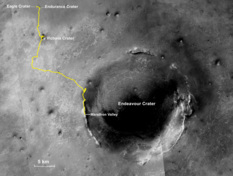
Opportunity's route so far
The gold line on this image, courtesy Larry Crumpler of the New Mexico Museum of Natural History and Science, shows Opportunity's route from the Eagle Crater landing site to her approximate current location. Since August 2011, the MER mission has been investigating the western rim of Endeavour Crater, which spans about 22 kilometers (about 13.7 miles) in diameter. The base image for the map, all within the Meridiani Planum region of equatorial Mars, is a mosaic of images taken by the Context Camera onboard the Mars Reconnaissance Orbiter (MRO).NASA /JPL-Caltech / MSSS / NMMNHS
In late August 2012, the MER team, using additional observations that Arvidson, a co-investigator on CRISM, collected from the infrared spectrometer, homed in on a "weak but real" signal for clay minerals. He then meticulously pinpointed the "sweet spot" to a hill in the Cape York segment of Endeavour’s eroded western rim that was named for MARs rover pioneer Jake Matijevic, one of the original "creators" of Spirit and Opportunity at JPL, who had just passed away.
Since Opportunity was traveling south along the Cape York segment near the hill, the timing was perfect. For Squyres, MER principal investigator of Cornell University, Arvidson, and most of the other MER scientists, it was a no-brainer. They commanded the rover to "slam on the brakes and take a hard right," as Squyres put it then, and head up Matijevic Hill.
There, for the first time in all her years on Mars, the robot field geologist found undeniable evidence for past near-neutral water the likes of which humans could probably drink.
That evidence was in the form of phyllosilicates, specifically smectite clay minerals, exactly what it had come to Endeavour Crater to ground-truth, exactly what CRISM detected and indicated would be there. It put the MER scientists over the Martian moons and the mission made space exploration history again, this time as the first surface mission to send home evidence of these telling clay minerals.
The CRISM data also directed the mission to Marathon Valley, where the signals from the orbiting spectrometer are much stronger and indicate a veritable bounty of three or four different kinds of smectite clay minerals. In addition, aerial imagery of Marathon Valley reveals a more defined stratigraphy in places, stratigraphy that must harbor evidence of Mars' ancient history and watery environment there.
After Opportunity finishes taking images of the valley from the entry point, “we will drive inside and then probably do a walkabout through the valley and to see what's where,” Golombek said.
The MER team will be looking for areas in Marathon Valley that feature a number of north-facing slopes where the solar-powered rover can angle her arrays toward the winter Sun in the northern sky to glean as much sunlight “fuel” as possible during the harsh season. Then as the Martian winter sets in [around the beginning of 2016], “we will decide where we might want to be perched for the winter months,” said Golombek.
The excitement about finally getting into the valley is really building now. It has, after all, been a destination years in the roving. "This is what we came here to do and it is the objective of our extended mission plan – explore Marathon Valley and the clays that CRISM indicates are abundant in this valley," said Callas. "Now, we're poised to go in and check it out."
J.J. Wray, et al., "Phyllosilicates and sulfates at Endeavour Crater, Meridiani Planum, Mars," Geophysical Research Letters, Nov. 4, 2009.

NASA / JPL-Caltech / Cornell University / Arizona State University
Marathon Valley overlook
This view from Opportunity shows part of Marathon Valley as seen from an overlook north of the valley. The landscape is presented in false color, a process that makes it easier to see differences in surface materials. The scene spans from east, at left, to southeast. The image combines exposures the rover took through three of the Pancam's color filters, centered on wavelengths of 753 nanometers (near-infrared), 535 nanometers (green) and 432 nanometers (violet), at each of the four camera pointings.Support our core enterprises
Your support powers our mission to explore worlds, find life, and defend Earth. You make all the difference when you make a gift. Give today!
Donate

 Explore Worlds
Explore Worlds Find Life
Find Life Defend Earth
Defend Earth


